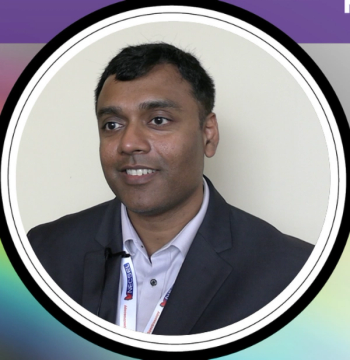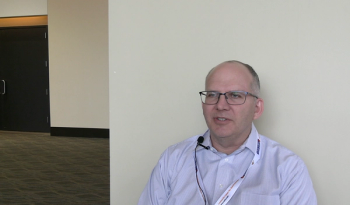
Advancing In Situ Applications of Spectroscopy in an Industrial Setting
The 2019 recipient of the Clara Craver award, Xiaoyun (Shawn) Chen, is a senior research scientist working in the Core R&D Analytical Sciences department of the Dow Chemical Company. Chen, who will receive this award this fall at SciX 2019 in Palm Springs, California, recently spoke to Spectroscopy about his work.
The Clara Craver award, awarded annually since 2006 by the Coblentz Society, was named after Craver in recognition of her pioneering efforts in promoting the practice of infrared vibrational spectroscopy and her many years of service to the Coblentz Society. The award recognizes the efforts of young professional spectroscopists and their contributions in applied analytical vibrational spectroscopy. The 2019 recipient, Xiaoyun (Shawn) Chen, is a senior research scientist working in the Core R&D Analytical Sciences department of the Dow Chemical Company. Chen has been leading Dow’s global optical spectroscopy technology network since 2013, and also the molecular structure capability since 2016. Through his work at Dow sites around the world, Chen not only helps solve a broad range of problems and improve many different types of R&D and production processes, but also has the joy of introducing many colleagues, such as process engineers and synthetic chemists, to the benefits of spectroscopy for their applications. Chen, who will receive this award this fall at SciX 2019 in Palm Springs, California, recently spoke to Spectroscopy about his work.
You have over a decade of experience in spectroscopic and chemometric method development for industrial research and development (R&D) and manufacturing projects, focusing on in situ reaction monitoring. What motivated you to focus on this area?
Let me begin with how I got started. It was probably around my third year at Dow, and I was working on whatever projects that happened to come my way, when my mentor, Anne Leugers, handed me two attenuated total reflectance (ATR) dipper probes, which were no longer needed by another group, and told me to explore whether I could make use of them. By chance, several colleagues in our engineering and process science group reached out to us to monitor a low-temperature reaction that they could not seem to grasp with conventional off-line methods such as gas chromatography (GC), liquid chromatography (LC), or nuclear magnetic resonance (NMR) spectroscopy. We borrowed another Fourier-transform infrared (FT-IR) instrument from our process analytical group, so that we could use the ATR dipper probe to monitor that reaction. In situ monitoring immediately helped us to detect and prove the existence of a highly labile intermediate, which explained why earlier off-line analysis failed. The focus of the project then shifted to characterizing the reaction kinetics for process optimization, and, as a result, we needed to find a way to quantify the concentration of all reaction species. I was very fortunate that Randy Pell, a world-renowned chemometrician, became my mentor in chemometrics, and together we were able to apply several chemometric tools such as classical least squares (CLS) and partial least squares (PLS) to quantify all the reaction species within the complex mixture. This work was later published externally (1).
So, that was how I got started-as a confluence of instrument and probe availability and project need. I was truly amazed by how useful and enabling in situ spectroscopy turned out to be. The results from in situ IR substantially impacted the direction of that particular project and the work of multiple PhD-level process chemists and engineers. As encouraged by my mentors and my leaders, I started to make an intentional effort to further explore and identify similar opportunities. Very quickly, it became apparent to me that the in situ spectroscopy project was not a lucky one-off, but that there were actually many projects that would benefit. Even though people might not know how they could benefit from in situ spectroscopy, I took it upon myself to champion the application of in situ spectroscopy throughout Dow, and even outside. Since then, I just became naturally drawn to that method, and often had to force myself not to be solely focused on in situ spectroscopy. I truly believe that in situ spectroscopy can be a revolutionary tool for process monitoring.
How broad is the range of projects that you work on? Are the projects very similar to each other, or diverse?
Extremely broad. Let me start with types of projects. Currently, I have several projects dealing with silicone, a few dealing with catalysts ranging from zeolites to MOF, one related to radical polymerization, one related to polyurethane foaming, several related to ethylene polymerization, and several related to customer applications, such as paper coating and airbag coating, among others. In terms of commercialization stages of these projects, they may range from early stage concept-shaping, to process development, to customer applications. There is never a dull moment as far as projects are concerned. The only common theme among them all is that they all can benefit from the use of optical spectroscopy.
What are the biggest challenges you tend to encounter in your work?
Time management, motivating others, and delegation. There are many things you need to do well as an industrial analytical scientist. First, you need to make sure that you are working on important and relevant research topics. In my current role, I also need to make sure that we keep abreast of the latest analytical instrument development, so that we can solve the toughest analytical problems with the newest tools. We also need to deliver on on-going existing projects, look out for new projects, document past projects, and mentor new people. Whether you can manage your time well among all the above-mentioned tasks is critical in determining how fulfilled, productive, and successful you can be. I forgot to mention that additionally you may also need to maintain an external presence, and I do that by serving as the newsletter editor for the Society of Applied Spectroscopy (SAS), and on the board of the Coblentz Society, and by continuing to publish in peer-reviewed journals. Motivating others and delegation are things that aren’t necessarily taught at graduate school, but become increasingly important as you progress through your career. They are often easier said than done, and I am fortunate to have several great leaders and mentors who have been coaching me throughout this process. I don’t feel I am an expert in them yet, but am trying very hard to be better at them.
You recently published a study about monitoring polyimide production using a combination of in situ infrared and Raman spectroscopy (2). Why did you use both techniques in the study? What was different about what the two techniques enabled you to see? Can the results of that study guide your choice for IR or Raman spectroscopy for future studies?
The short answer to your first question is “because we can.” I routinely take an IR, Raman, and NIR spectrometer with me when I visit my colleagues at their labs. Sometimes there’s a clear winner regarding which type of spectroscopy will be the best fit, and we’ll just use that. Just as often, we cannot really predict which technique will work best, and then we try all of them. Which technique is the most appropriate also depends on the focus of the project, which may continue to shift as we make progress. Often optical spectroscopy may not be the right tool, and then we’ll bring in other analytical tools as well, though that’s probably outside the scope for this interview. You’ll have to read that paper to see our exact findings. For this particular study, I would say both techniques would eventually lead to similar findings, though your perspective into the reaction progress would be very different, due to the different selection rules. Another advantage of using such a broad range of techniques lies in the insights potentially offered by them. There have also been numerous times when we originally set out to solve one problem, but discovered something totally unexpected, which led the whole project to take on a new direction.
You published another recent study on the simultaneous in situ monitoring of trimethoxysilane reactions using Raman, infrared, and nuclear magnetic resonance spectroscopy. What advantage did each technique provide to this study, and what did each technique reveal about the reaction kinetics?
Exact details about the pros and cons for each technique are quite nuanced, and hard to generalize. It’s probably fair to say that in general, NMR offers the most structural details, but tends to be more cumbersome and expensive to implement, while IR and Raman are very versatile, and their field-deployment is becoming a trivial task nowadays.
You have introduced and implemented in situ spectroscopy to more than 10 Dow sites globally. What are the challenges in working with sites around the world? Did they vary from locale to locale?
Every site is different in its focus, functions, product lines, and capabilities. As a result, the researchers I interact with can be very different for sites focused on technical service, on manufacturing, or on R&D. However, I enjoy interacting with all of them, and I don’t really think there are too many challenges. Rather, I view each visit as a new opportunity to learn from folks at that site, and I adapt my own style to maximize the value of my visit. You have to be prepared to use different “languages” when you talk about spectroscopy with chemists, scale-up engineers, quality control (QC) lab analysts, process design engineers, and your fellow spectroscopists. There are also different cultures and traditions, especially for sites outside North America. My visits to Europe, Japan, South Korea, Turkey, and China were especially memorable, due to the different styles of those sites. I’m also proud to say that my work, once in a while, also influences external customers, and there have been R&D scientists in other companies working with Dow who have adopted the methods we developed.
What do you consider to be the most satisfying aspects of mentoring junior spectroscopists, as well as introducing those unfamiliar with spectroscopy to the techniques?
As I am starting my 12th year with Dow, I am also starting to take on new roles, and one of the most important ones is to mentor young people coming to our group. I feel very lucky that I have the chance to interact with the brightest minds coming out of graduate school, and I feel especially privileged to see that such bright young people actually take on my advice as they start to navigate their first “real world” job. Seeing their maturing into driven and motivated researcher is the most satisfying part. As for introducing spectroscopy to those outside the field of spectroscopy (which is the case for ~98% of the colleagues I interact with), that’s almost an infinite source of joy for me. I can still vividly remember the first time when my friend Doug Bland told me that he didn’t believe my in situ IR results, because they didn’t line up with the earlier GC results he had been getting for two years, and his subsequent “conversion” and full embracement of in situ spectroscopy. Changing people’s minds and attitudes is often the most challenging part, but definitely the most rewarding part when you manage to do so. I now have many colleagues who no longer treat in situ spectroscopy as the last resort after they cannot use GC or LC, but rather first try to monitor their reactions with IR or Raman, and only move on to GC or LC when IR and Raman don’t work sufficiently well (which does happen from time to time). I’m very proud of this.
What do you think are the aspect of working in industry that scientists in academia don’t understand or appreciate?
I am not sure whether it is true that academic scientists don’t understand or appreciate industrial scientists. Everyone has his or her own focus and perspective. Even within my own group, I don’t think I always understand or appreciate the importance of another fellow spectroscopist’s work. For example, I have fellow spectroscopists who spend all their time in QC labs or QC method development, and colleagues who devote themselves to process analytical, and still others whose focus was on the data management side, such as library, data communication, and chemometrics. I think we all need to put ourselves into others’ shoes to really appreciate each other more. Along the same lines, maybe it’s really the diverse type of work we do in industry that may be something not fully understood or appreciated by outsiders. We also face very different types of pressure in industry. While we usually do not get stressed out by funding or teaching, there are many other things that you have to keep abreast of to do your job well, such as keeping up with the latest technology development, ensuring a robust project pipeline, creating a roadmap to ensure that we have the most relevant capabilities matching the company’s direction, and last, but not the least, meeting the ever-changing customer and market needs.
References
- R.J.Pell and X. Chen, J. Chemom. 28(5), 319-489 (2014) DOI: 10.1002/cem.2507
- X. Chen, Q.M. Wang, and L. Bu, Appl. Spectrosc. 71(9), 1-8, (2017) DOI: 10.1177/0003702817700427
Newsletter
Get essential updates on the latest spectroscopy technologies, regulatory standards, and best practices—subscribe today to Spectroscopy.




